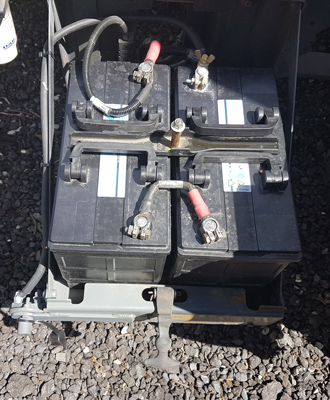Quick Answer
A battery bank is made up of two or more batteries connected together, either in series or in parallel (see Building a battery bank using amp hour batteries for more on these two wiring techniques).
A battery is made up of one or more cells. A battery with one cell is often referred to as a ‘single cell battery‘. When there is more than one cell, they are connected together internally in series, but from the outside they usually look like a single item (one positive and one negative terminal).
A cell in its simplest form, when we’re talking about batteries, is one metallic cathode (positive), one metallic anode (negative) and electrolyte. The metals used in the cathode and anode and the liquid or material that makes up the electrolyte vary as various combinations have been discovered over the last two centuries which each have different strengths and weaknesses.
The cell
The basic cell of a battery uses two pieces of different metal – known as the cathode (positive) and the anode (negative). Internally, they are kept separate, but both are in contact with the same electrolyte where chemical reactions take place which create the electrical charge.
The metals used vary depending on the battery type. The clue is sometimes in the name – Lead acid batteries do indeed use lead plates with an active paste of sponge lead applied to the negative anode plates and lead dioxide plates to the positive cathode. The electrolyte is acid. At other times the name is misleading. There is no lithium, for example, in a lithium-ion battery.
The electrolyte can vary greatly from a completely liquid acid to a moist paste to a dry powder, but it is here that the chemical reaction takes place which produces electricity when the cathode and anode are connected to each other via an external appliance such as a light bulb.
If the cathode and anode were connected to each other directly, the same chemical reaction would take place, but without any appliance to slow it down a massive amount of heat is generated which can lead to explosions or fires.
In reality, the need to make batteries small means the cathode and anode are often extremely close to each other and so most modern day cells include a separator, a porous material (usually in sheet form) to make sure the cathode and anode do not touch while allowing the electrolyte, or parts of it, to move freely between the two..
For more on the process of how a cell works see How a battery works.
Single cell batteries
Most household batteries like the ones that power remote controls and alarm clocks are actually cells, but this naming error has become everyday language, wrong though it is technically.
Some people refer to these as single cell batteries, but if you think about it, that’s contradictory. A battery is defined as “a set of similar units” and a single cell isn’t a set.
But, we won’t be changing the world’s vocabulary any time soon, so it is accepted that a battery can be one or more cells. The Oxford dictionary defines a battery as “A container consisting of one or more cells, in which chemical energy is converted into electricity and used as a source of power:”

A battery
Cells on their own don’t offer much power. Nickel Metal-Hydride cells are 1.2 volts, while even the latest lithium cells reach only 3.5 volts. For many smaller applications such as an LED flashlights, either chemistry is fine. When it comes to doing something harder, like starting an engine, a single cell won’t manage.
As such, creating a single product containing multiple cells connected together was the obvious solution. The starter battery for a car engine is usually 6 lead acid cells, each with a voltage of 2, connected in series to create a 12 volt battery. In reality, each cell is actually usually 2.1 volts and the battery is 12.7 volts, but for commercial simplicity they are referred to as 12 volt batteries.
In this situation we have a genuine ‘battery’ of cells.
A battery bank

Although creating single products with multiple cells is the best solution, there are limits. A lead acid battery containing dozens of cells would be impossible to lift and is therefore impracticable. If one cell were to fail, the costs of repair or replacement would also be excessively high.
So when you need even more power, the best solution is to wire multiple batteries together. This is a battery bank.
How you wire them together affects the final amperage or voltage of the battery bank (see building a battery bank with amp hours batteries for examples and an explanation on how this works).
A battery bank can be made up of single cell batteries or multiple cell batteries. One every day example of multiple cell batteries wired together in series can often be found on large trucks where we have:
- two batteries each containing six 2 volt cells to produce 12 volts
- wired together in series to create a battery bank with a cross circuit voltage of 24 volts
This approach provides enough power to start the large diesel engines. A single battery could be produced to do the same job, but it would be so heavy and large that lifting and handling could only be done with extreme difficulty.
Why it gets confusing
The root cause of the confusion really comes from our acceptance to call a single cell battery, a battery. Let’s see that in action.
If you open up a laptop or power tool battery, what you find inside are what looks like lots of smaller batteries wired together as shown in the picture below:

Now if you squint your eyes, you’ll see the purple units inside are marked Samsung ICR18650-26C. Look that up and you’ll find most people refer to the ICR18650-26C as a ‘battery’.
So doesn’t that mean that what you have in the back of your laptop is a battery bank, not a battery? No. The error is that the ICR18650-26C is actually a cell (it shouldn’t technically be called a battery, but everyone does), so your laptop battery really is a battery made up of multiple cells. Each Samsung ICR18650-26C is a cell as marked in the picture.

However looks can also be deceptive. The battery pictured here looks like a single cell battery, but is actually made up of several smaller cells vacuum wrapped together.
It is a ‘battery’ of cells in the genuine sense of the word.
The giveaway is usually in the voltage. The pictured example is a A134 Alkaline disposable (primary) 6 volt battery, but Alkaline primary cells only have a cross circuit voltage of 1.5 volts, so we can tell that this battery must actually be made up of four alkaline single cell batteries connected in series.


Is there such thing as a portable wheelchair charger
Yes..
There are various car charges available you can use to charge your wheelchair battery. You charge the battery right from your Car Cigarette Lighter receptacle or USB. It takes the Voltage coming out and Outputs the required Voltage needed to recharge your Battery. These type of chargers can connect Directly to your Battery, so you can charge the battery right from the Car or you can connect it to the Joystick port, to charge the Battery while it is On-Board. There are also various battery banks on the market you can carry with you to juice up the battery when it is low from any location. Various wheelchair companies have these available as well as manufacturers with general purpose chargers. Just make sure and match up your battery to the correct device based on the Volts and mAh requirements.